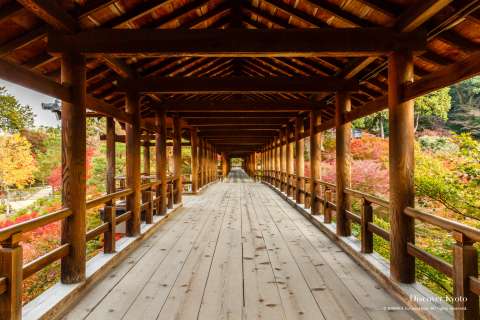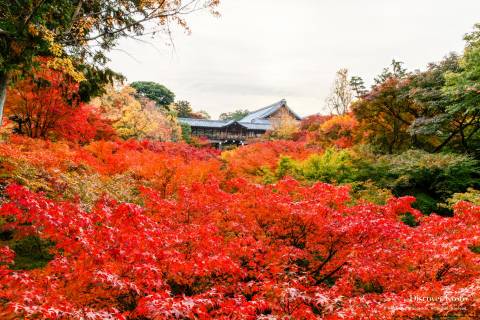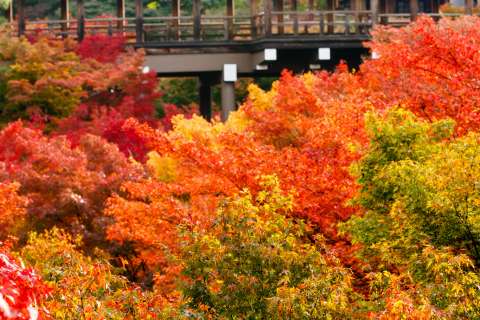Tōfuku-ji|東福寺
Overview

One of the Five Great Zen Temples in Kyoto, Tōfuku-ji was founded in 1236 by a famous monk Enni Ben’en who had recently returned from studying Rinzai Zen Buddhism in China. The large sanmon gate at Tōfuku-ji is actually one of the oldest of its kind in Japan, and the grounds contain numerous sub-temples, but Tōfuku-ji’s true attraction for tourists is its myriad of amazing gardens. Some of the gardens are as new as the 20th century, when the art of Japanese garden design underwent a sort of modern renaissance. Within the Abbots’ Quarters is an iconic, checkerboard-esque moss garden as well as a sprawling Zen rock garden along the front of the hall. Most famous, however, is Tōfuku-ji’s Tsūten-kyō bridge, a raised, covered walkway that spans a small valley filled with Japanese maples. Visitors can also access the strolling garden that makes up the shallow valley and its sides, and across the bridge lays another small complex around the Founder’s Hall, which also features a charming garden that includes both Zen rock features and shakkei, borrowed scenery.
Tōfuku-ji’s true attraction for tourists is its myriad of amazing gardens, some as new as the 20th century, when the art of Japanese garden design underwent a sort of modern renaissance.
Features
Tsūten-kyō Bridge

A famous and often photographed sight in the summer and fall, the Tsūten-kyō Bridge connects the main precincts of Tōfuku-ji with the slightly removed Founder’s Hall, stretching over a small, shallow valley filled with maple trees (momiji) along a stream. With how the wooden bridge is placed and how many maples are planted below, the tips of their leaves just reaching the bottom of the bridge, it appears that the Tsūten-kyō cuts across a sea of tree leaves, or floats on a green or red cloud, depending on the season. You can cross the Tsūten-kyō for a ¥400 fee, or view it from the pedestrian bridge Gaun-kyō that visitors usually cross on their way to enter the temple.
Abbot’s Quarters Gardens

While the Hōjō (Abbot’s Quarters) of Tōfuku-ji is a beautiful piece of architecture and features lovely, open halls with classical artwork such as painted screens and golden altars, the real charm is found in the gardens surrounding the building itself. Placed in 1939 and designed by Shigemori Mirei, a famous modern garden architect, the Hōjō boasts four gardens, one at each cardinal direction. The southern garden is a classic Zen dry landscape garden with four sacred mountains in the Chinese mythology represented in stone amongst carefully raked patterns in the sand. To the west is a garden of moss and azalea scrubs pruned into a checker pattern, and the east features seven pillars amidst sand and moss that form the shape of Ursa Major, the Big Dipper. To the north, with a view of the Tsūten-kyō over the garden wall, is a quaint pattern of moss and square checks that fades into a backdrop of azalea bushes.
Sanmon Gate

The large sanmon gate at Tōfuku-ji is actually one of the oldest of its kind in Japan, with the current structure dating to 1425 when it was rebuilt after being destroyed by fire. Two stories and 22 meters high, the gate towers over the complex with a name plate said to have been written by the Shogun Ashikaga Yoshimochi and containing paintings by famous artists on the ceilings within.
Sub-Temple: Funda-in, “Sesshū-ji”
The family temple of the Ichijō clan, founded in the 14th century, Funda-in gained a greater reputation in connection to the famous ink painter and designer Sesshū (1420-1506) who is said to have designed the southern “crane and turtle” garden, one of the oldest of its type in the city. The sub-temple’s gardens can be viewed from a wooden veranda, and also features a lovely tearoom with an often photographed circular window that offers a peek of the gardens as well. Burned down twice in its history, the current reconstruction dates to 1899.
History
One of the Five Great Zen Temples in Kyoto, Tōfuku-ji was founded in 1236 with support from imperial regent Kujō Michiie (1193–1252), who wanted to build large temples in Kyoto equitable to the great complexes in Nara. Tōfuku-ji’s name is actually constructed using kanji characters from the two most famous temples there: Tōdai-ji and Kōfuku-ji. The famed monk Enni Ben’en (1202–1280), who had recently returned from studying Rinzai Zen Buddhism in China, was chosen as the founding abbot.
Though the temple burned down in the 14th century, it was rebuilt according to the original plans, and many of the sub-temples and other compounds largely avoided damage until the Meiji Period when a fire broke out in the Buddha Hall. Once reconstructions were financed Shigemori Mirei (1896–1975), a famous garden architect, designed new gardens and rehabilitated classic ones across the complex.
The grounds of Tōfuku-ji contain 25 sub-temples, though only a few are open to the public.
Access
Address
〒605-0981 京都府京都市 東山区本町15丁目778
| TEL | 075-561-0087 |
| FAX | 075-533-0621 |
| WEB | http://www.tofukuji.jp/english/ |
Admission
- General Admission: ¥400 (Tsūten-kyō, Founder’s Hall), ¥400 (Abbot’s Quarters)
Hours
- General Admission:
- 09:00 - 16:30 (April to October)
- 08:30 - 16:30 (November to early December)
- 09:00 - 16:00 (early December to March)
- Closed: No closing days
Transportation
- From Kyoto Station ⇒ Nara Line ⇒ Tōfuku-ji Station ⇒ 10 minutes walking
- Keihan Line ⇒ Tōfuku-ji Station ⇒ 10 minutes walking
- Kyoto City Bus ⇒ Route 208 ⇒ Tōfuku-ji Bus Stop ⇒ 10 minutes walking
Gallery
-




 +16
+16
